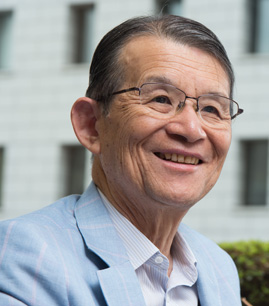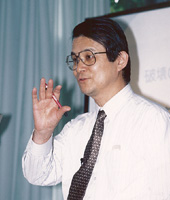- Home
- > Outreach
- > Publications
- > CONVERGENCE
- > LEADER’S VOICE
 LEADER’S VOICE
LEADER’S VOICE
Teruo Kishi
Innovate in Japan with a Global Perspective
MANA- confronted the challenges of internationalization head-on

Yes, and in fact, MANA's efforts have far exceeded my expectations in some areas. From what I see, the way MANA has established directions for research, for example, in creating the 4 Research Fields of "Nano Materials," "Nano Systems," "Nano Power," and "Nano Life," and identifying the 5 key tools of nanoarchitectonics that support those fields, can be considered extremely good. The Director-General, Prof. Aono, has really worked hard in this regard. Where the research system is concerned, the achievements of the Chief Operating Officer, Prof. Bando, were also quite large. Prof. Bando nurtured the original International Center for Young Scientists which NIMS inaugurated in 2003, and made its successor organization, the International Center for Young Scientists, or ICYS, the foundation for training young MANA researchers. Internationalization is an important keyword in Japan, and MANA has confronted the challenges of internationalization head-on.
In this way, MANA has become the greatest treasure of NIMS, not only standing shoulder to shoulder with Japan's first class universities, but also enjoying a global reputation. Objectively, as well, I think that MANA's presence is evident.
I haven't kept up with all the developments at MANA recently, so it's difficult to talk about evaluation, but for example, I hope that Dr. Takayoshi Sasaki's research results in nanosheets can contribute to the energy and biomaterials fields. In superconductivity, the fact that MANA has produced hits somehow is interesting. In high temperature superconductivity, in other words, how to bring it closer to materials that can be used at room temperature, is a challenge, and I hope that this will be realized sometime. Likewise, in the field of polymers, Dr. Katsuhiko Ariga's group and other groups are making a variety of efforts, and I feel that they are headed in a good direction. Atomic switches are also moving toward practical application.
If an achievement wins the Nobel Prize, there's a tendency in Japan to consider it perfect, but to begin with, there are fields where it's easy to win the Nobel Prize, and others where it isn't. For that reason, it's difficult to say anything. In any case, in research, there are eight ways to succeed and eight ways to fail, so to speak, and success isn't all that easy. If we were successful every time, science would make too much progress. (Laughs) Considering that, I think MANA is putting up a good fight under the new concept of "nanoarchitectonics," and producing good results across the board in basic research fields. Of course, the basic researches with a clear purpose will lead to the innovation in the next generation.
Time to "reset" Japan as a whole
Since the foundation of the WPI Program is basic research, there's an impression that its feet are planted more firmly on the ground than programs that aim directly at innovation. I feel that the WPI Program has succeeded, in the sense of providing a driving force for the country's basic research, because a strong system was created when the program was started up.
The original five WPI centers, including MANA, were only launched in 2007, but I hear that there is debate about whether to extend their support period or not, and I'm somewhat anxious about that. Because new research buildings have been purposely built and outstanding research environments were created, I hope that those concerned will also provide an appropriate support period. This situation can also be seen in the competition between centers, but since the respective WPI centers are involved in research in completely different fields, I feel that an evaluation is difficult. It's like asking about the relative superiority of two things that can't be compared, like which is better, a Persian cat or a bulldog?
There are two things that I'd like to recommend to the current government. One is strengthening the Council for Science, Technology and Innovation. At present, the fields of space, nuclear power, marine sciences, and large-scale machinery and equipment are outside the purview of this council and as a result, they only have influence on one-third of Japan's science and technology budget. These fields should also be brought together to create a "total" council in the true sense. The second thing is to raise the question of what to do about large scientific research cities. Of course, Tsukuba where NIMS is located, Keihanna or Kansai Science City, and also Okinawa should be considered.
Looking back on the past, until the 1980s, Japan was playing catch-up. Around 1990, there was strong pressure from the United States to put greater effort into common infrastructural technologies, and in response, Japan enacted the Science and Technology Basic Law in 1995. Almost 20 years have passed since that time, and I think that Japan now has a full-blown case of systemic fatigue. One cause of that fatigue, after all, is the rise of China, but after 20 years, and the accompanying systemic fatigue, it's time to "reset" Japan as a whole.
People often mention "review of Independent Administrative Institutions or IAIs," and the like, but in addition to R&D related IAIs, Research Institutes and Centers of Japanese National Universities and National Joint-Use Research Facilities exist throughout Japan. In this situation, no large improvement can be expected by focusing only on the IAIs. For example, in addition to NIMS, there are also other large research centers in the materials field, namely, the Institute for Materials Research and the Institute of Multidisciplinary Research for Advanced Materials, both of which are at Tohoku University, and it is necessary to think about these research centers in a total way. This doesn't mean merging their organizations, but the role of the respective organizations should be studied, while considering the research and development strategy of Japan as a whole. Unless we do this, we can't hope to compete with rivals like the United States and China.
Frankly speaking, I have the impression that research misconduct is on the increase in Japan as a whole. Although research is originally a process of producing and publishing research results, there is a tendency for simply publishing papers to become the purpose of research. An attitude of cutting corners and trying to publish as many papers as possible probably tends to encourage actual misconduct. This seems to show the effects of falling into the pay-for-performance system and the general rush to win competitive funding. Perhaps that's the kind of period we live in at present, but it is an extremely difficult problem.
Global human resources development and exchanges of human resources
The largest problem for Japan today is the quality of people with doctoral degrees. The tendency among outstanding people to stop at the master's degree and not to go on to the doctoral level is also driving this situation. If researchers don't aim in an independent direction from an early stage, they'll never be able to stand on their own two feet. However, since there's a tendency in Japan not to question authority, that's difficult. In the educational system in doctoral programs, I think we should introduce the kind of systems that are used in other countries and create a system on that basis, for example, by increasing the number of academic advisors to two, and not including the advisors in the examination of the doctoral dissertation.
If I could advise on the side of a young person, an attitude of returning to the starting point and doing new things and trying things that others aren't doing is necessary. It's also a problem that the post-doctoral period is too long, and it would be better if people didn't hesitate to go into private companies.
MANA has realized the leading international environment in Japan. However, it would be good if the world's real super-elite researchers could come to MANA more frequently on sabbaticals, whether it's for 3 months, or for 1 month. In comparison with Oxford and Cambridge and similar institutions, I feel that the global exchange of human resources is still a bit insufficient. I hope that MANA will become a place that materials and nanotechnology researchers feel they must visit at least once.
Tsukuba is a key area, including from the viewpoint of strengthening Japan's innovation and industrial competitiveness. In this, MANA should give its best efforts to basic and fundamental research, without losing the focus of its position, while also making actively preparations to ensure a smooth transition to practical application whenever researchers produce good results. In the future, I hope that you will continue to play an active role, as a division that supports the foundations of NIMS.

Prof. Kishi in his young days

